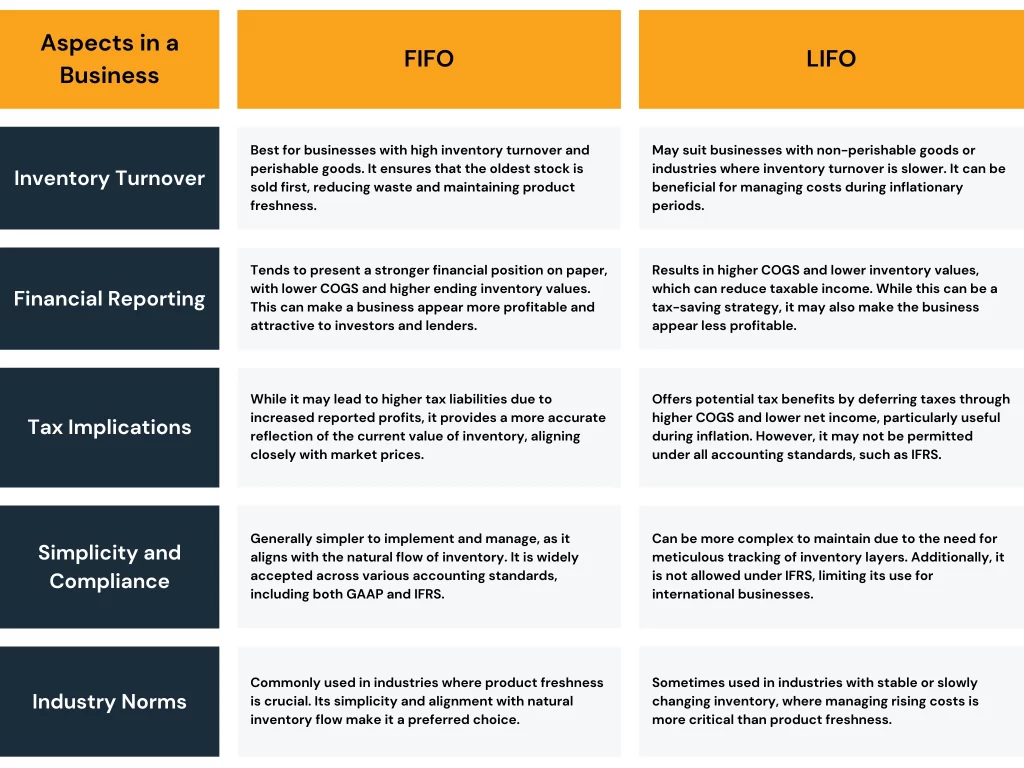In the world of inventory management, understanding different methodologies is crucial for efficient operations and accurate financial reporting. One such method is FIFO, or First In, First Out, a commonly used inventory valuation technique. This blog will explore what FIFO stands for, compare it to other methodologies like LIFO (Last In, First Out), and delve into its advantages, disadvantages, and applications.
What Does FIFO Stand For?
FIFO stands for First In, First Out. This inventory management method assumes that the first items added to inventory are the first ones sold or used. In other words, the oldest inventory items are prioritised over newer stock. This system operates on the principle that selling or using the oldest products first helps maintain inventory accuracy and reduces the risk of holding outdated or expired stock.
FIFO is particularly advantageous in industries where product expiration dates are a significant concern. For instance, in the food industry, products have a limited shelf life, and using the oldest stock first ensures that items are sold or used before they expire, therefore minimising waste and ensuring product safety. Similarly, in the pharmaceutical industry, where products also have expiration dates and must meet stringent regulatory standards, FIFO helps in maintaining compliance and ensuring that consumers receive effective and safe medications.
What Industries is FIFO Used In?
Besides food and pharmaceuticals, FIFO is widely used in other industries, including:
Retail: Retailers often use FIFO to manage perishable goods, seasonal products, and fashion items, ensuring that older stock is sold before it becomes outdated or obsolete.
Manufacturing: In manufacturing, FIFO is used to manage raw materials and components, ensuring that older materials are used first to maintain quality and reduce waste.
Automotive: Car manufacturers and parts suppliers use FIFO to manage inventory, ensuring that parts are used in the order they were received, which helps in maintaining consistency and reducing the risk of parts becoming obsolete.
Technology: In the technology sector, where products can quickly become outdated, FIFO helps manage inventory turnover and ensures that older models are sold before new releases.
Healthcare: Hospitals and medical facilities use FIFO to manage medical supplies and equipment, ensuring that items with expiration dates are used in a timely manner to maintain safety and efficacy.
FIFO vs. LIFO
When discussing inventory methodologies, it’s important to compare FIFO vs. LIFO. While FIFO prioritises selling the oldest inventory first, LIFO assumes the most recently acquired items are sold first. This distinction impacts financial reporting, especially during periods of fluctuating prices. FIFO typically results in lower cost of goods sold (COGS) and higher inventory value on the balance sheet during inflationary periods. In contrast, LIFO can reduce tax liabilities by increasing COGS and lowering taxable income in the same inflationary context.

Other Inventory Methodologies
When managing inventory, businesses have several methodologies to choose from, each with unique advantages and best-suited applications. Besides FIFO and LIFO, other inventory methodologies include Weighted Average Cost and Specific Identification. Understanding these methods helps businesses select the most appropriate strategy for their operational and financial needs, particularly for those involved in 3PL fulfilment and eCommerce fulfilment.
Advantages and Disadvantages of FIFO
When you consider the FIFO inventory methodology, it’s important to weigh both its advantages and disadvantages. This approach offers several benefits, particularly in terms of simplicity, transparency, and reducing waste. However, it also presents potential drawbacks, especially regarding tax implications and profit reporting during inflationary periods.
Advantages:
Simplicity: FIFO is straightforward to implement, aligning with the natural flow of inventory, making it intuitive for businesses to manage.
Transparency: FIFO provides a transparent system for tracking inventory, making it easier to monitor the flow of goods.
Accuracy in Valuation: FIFO reflects current market conditions, providing a more accurate depiction of profit margins and inventory valuation.
Disadvantages:
Higher Taxes: During inflationary periods, FIFO leads to higher taxable income, affecting cash flow for businesses, especially those with tight margins.
Misleading Profits: FIFO can inflate profits during periods of rising costs, leading to potentially misleading financial statements.
Packpro and FIFO
At Packpro Fulfilment, we’re all about efficiency in managing supply chains, and one of our key tools is the FIFO inventory management system. This approach ensures that we use our older inventory first, minimising waste and keeping our products as fresh as possible. Powered by advanced inventory software designed specifically for our 3PL fulfilment operations, we efficiently rotate inventory to meet our clients’ needs promptly. Our warehouse is thoughtfully organised to ensure quick access to older inventory items, making order fulfilment both swift and effective. Financially, FIFO allows us to deliver clear and accurate reporting, giving our clients a transparent view of their inventory costs and operational performance. By integrating FIFO into our logistics strategy, PackPro remains committed to providing reliable and efficient supply chain solutions that consistently exceed client expectations, especially for those seeking 3PL Essex services.
Summary
In conclusion, the FIFO inventory management method plays a vital role in various industries by promoting the sale of older stock first, thus ensuring product safety and reducing waste. While it offers numerous advantages, such as simplicity and transparency, businesses must also consider potential drawbacks, particularly during inflationary periods. At Packpro, we leverage FIFO to optimise our 3PL fulfilment processes, providing our clients with accurate financial reporting and efficient inventory management. Understanding FIFO and its applications can significantly enhance operational effectiveness in eCommerce fulfilment and beyond.
